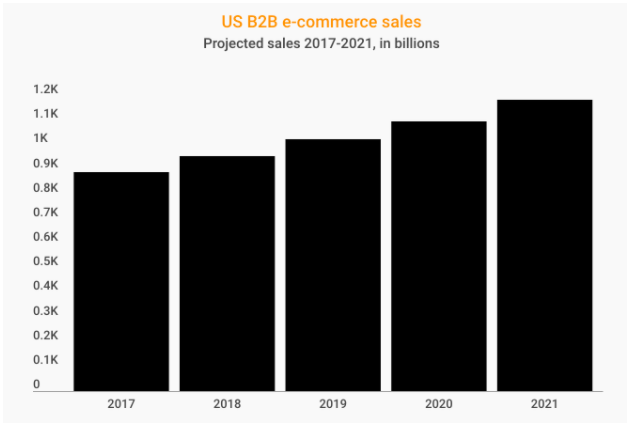Blog
The Digital Domination of B2B E-commerce Trends
Digital trends have virtually penetrated all sales marketplaces, and B2B operations are not exempt. As the world continues to barrel headfirst into an increasingly e-commerce-based method of transactions, companies are effectively left to choose between keeping up and getting left behind.
While B2B companies have historically been able to preserve many of their traditional ways, the tides are starting to turn. Ignoring digital solutions is no longer an option; using them is required to remain a competitive force in the market. There’s no way to get out on top when the competition takes innovative approaches and you’re trapped in old habits.
Marketing Director Melissa Buening puts the pros in plain English: “An E-commerce model can streamline the world of B2B sales by reducing the total cost to serve and sell to customers. It can help with reducing the time it takes to find products, improving order accuracy, reducing payment friction, and reducing customer service questions. E-commerce also enables customers to order products on their own schedule, make repeat purchases, and go paperless.”
Whether you want to increase your e-commerce activity or are looking for a way to implement best practices, a solid grasp of digital strategies is a key part of succeeding in an ever-changing environment. Read on to learn more about how B2B E-commerce trends are heading in an increasingly digital direction.
1. B2B voice commerce is growing.
Asking Alexa to make Amazon purchases is a growing trend in households around the world, but so far, there hasn’t been a great outlet for B2B operations to invest in voice. However, this is starting to change.
One of the largest hurdles in voice commerce overall is the complexity of some transactions. Simply instructing your smartphone to make a purchase has many limitations; there’s no way to browse available items, read reviews, or check dimensions. However, reordering items or purchasing generic products can be effectively handled with a voice command, which opens doors for sales outside of a B2C environment.
This model is the most likely to be adopted in the B2B marketplace as well. While more complex transactions still need to be carried out via traditional means, voice commerce offers compelling opportunities for completing routine transactions in a fraction of the time typically required.
Some businesses are also prepping for the possibility of voice engagement with Configure Price Quote software. Instead of using a conventional dashboard, customers may be able to request a quote via voice command, similarly saving time and energy when collecting information to be used in the purchase process.
2. B2B is embracing online marketplaces.
As a $1.2 trillion marketplace, B2B E-commerce holds much potential for facilitating transactions.

Historically, any e-commerce from a B2B perspective was largely limited to the interactions between companies. Still, the growing popularity of online marketplaces has left this concept a relic of days gone by. Marketplaces have existed for years in some forms — Amazon, for example, serves as both a B2B and B2C marketplace — but not at the scale currently seen.
To better facilitate sales, some larger companies, like Unilever and Honeywell, have launched their own marketplaces. While Unilever offers a liquidation marketplace aimed at selling surplus supplies in bulk, Honeywell maintains a true marketplace, called GoDirect Trade, for new and used airplane parts from establishments of all shapes and sizes. The first of its kind in the industry, Honeywell has managed to forge a valuable and highly unique path — before this, only 2.5% of aviation parts were purchased online.
This kind of careful preparation can be a major advantage; around 50% of companies with online storefronts feel confident that a majority of client portfolios will migrate to web-only purchasing. Furthermore, 75% of B2B purchases are expected to take place in the e-commerce marketplace by 2025.
3. Growing expectation of personalization.
The B2C market is already dominated by a trend toward personalization, providing a customized user experience based on everything from past orders to cookies. The B2B marketplaces have somewhat resisted this growing trend, but research indicates that increasing personalization efforts is a must. One study found that a personalized experience is a point of consideration for 50% of shoppers seeking online suppliers, while 48% spend more when their experience is customized.
Amazon is a master of personalization, using sophisticated algorithms to create a unique experience for every customer who logs in. B2B suppliers who want to stand out with clients in a similar manner should consider customizing buyer experience using data, like:
- Product recommendations based on browsing history or past purchases.
- Current location.
- Relevant promotions, like sales on previously purchased products.
- Demographic information, like key audiences.
In addition to providing a better user experience, personalization strategies can boost revenue, too. Showing buyers products better suited to their needs, just like Platinum Skincare does in a B2C space, increases the likelihood of closing a sale.

4. Demand in fast order fulfillment.
With overnight and even same-day delivery rolling out in B2C marketplaces around the world, it’s no surprise that B2B customers want the same experience — or that millennial business owners and operators are leading the rallying cry. As a generation that grew up with technology and has been at the forefront of its rapid evolution, the status quo isn’t good enough. B2B companies need to catch up to their counterparts or risk being left behind.
The answer to increasing fulfillment timelines is, in many cases, automation, on large and small scales. Smart warehouses are becoming increasingly common as well; replacing human laborers with robots can create safer conditions and faster speeds with a reduction in the risk of human error. Alibaba’s smart warehouse, for example, has been able to reduce human labor by 70%, leading to rapid results that best meet customer demands.
Even for companies that aren’t at the level of adding robots in their warehouses, there are automation options that see growth. The ability to create an automatic connection between completed orders and an order fulfillment service can accelerate the process of packing and shipping on a faster timeline.
5. B2B E-commerce self-service.
The world of sales, both B2B and B2C, has long relied on human interaction, from calling to order from a catalog to making small talk with a cashier. However, self-service is the name of today’s game, with customers preferring almost unilaterally to handle the purchasing process on their terms. An estimated 91% of the US population will be active in online shopping by 2023, demonstrating just how little the average individual wants to interact with others while making purchases of any kind.
However, as the world of B2C purchasing has gone fully self-service, there’s no reason to think B2B isn’t going in the same direction. Old-school mindsets are starting to change as a whole; today, over half of B2B buyers view self-service features as the most important factor when assessing online experiences.
Self-service purchasing is an important option, but it’s not the only way to support buyers who want to cut out the middleman. Other self-service solutions can exist in a wide variety of options, including:
- Subscription enrollment and scheduling.
- Customization options, including color, size, scale, and special features.
- The ability to schedule and reschedule order and fulfillment details.
- Options to update delivery options as needed.
Not only can these opportunities significantly ease the burden on buyers, but B2B distributors can also cut down on the human labor required to manage sales relationships, saving both time and money.
6. Increase in B2B omnichannel.
The path to B2B purchases can be long indeed, with the average buyer going through six different channels while weighing purchase decisions. And, unfortunately, it often isn’t a happy journey, with a majority of buyers experiencing frustrations with the process along the way.
As the B2B world is still very fragmented, with a shrinking but still distinct portion of the market preferring more traditional avenues, an extended reach is a benefit indeed. An omnichannel approach allows businesses to diversify, reaching customers across as many platforms as possible. When availability is enhanced in this manner, it can diminish frustrations and improve brand perception, leading to an increased likelihood of successful sales — and an untarnished image.
From direct sales to indirect sales to e-commerce marketplaces, there are plenty of places to go to win over customers. However, there’s a difference between choosing to be everywhere and choosing a multitude of avenues that make sense. After all, an omnichannel approach is only as good as the strategy behind it. To best maximize exposure while minimizing wasted resources, companies are encouraged to keep two significant factors in mind: where your customers prefer to access you and which routes make the most sense in targeting your key demographics.
7. B2B becomes eco-conscious.
As the topic of global warming and the potential for serious ramifications hangs heavy over business operations of all kinds, more and more people feel compelled to make environmentally friendly decisions. Just as B2C companies favor eco-conscious production, marketing, and fulfillment, the same is true for B2B avenues.
If you employ any measures that indicate eco-friendly strategies, it’s best to state this as clearly as possible across all of your sales platforms. Customers need to know why and how you have managed to minimize your footprint, indicating what makes choosing your business the right decision. If possible, quantify your impact, like the amount that changing production methods reduce your carbon footprint.
Taking eco-conscious steps in production and manufacturing is certainly a great start, but there are ways to take a passion for the environment further into the digital sphere, too. Some companies, for example, are refining things, like fulfillment schedules, to reduce the impact that can come with shipping and delivery. While a seemingly small step in the big picture, these kinds of little gestures can add up to those who value them while being easily ignored by those who don’t.
With an average of 27% of revenues coming from online platforms, it’s clear that B2B sellers see the inevitability of wide-scale e-commerce operations. Despite this, there’s still a long way to go to get everyone on board. However, brands that understand the current trends and are willing to undergo the digital transformation process are far more likely to see long-term success.
Conclusion
As digital technologies evolve, we will see B2B e-commerce businesses adopt digital strategies to better serve their customers. B2B e-commerce will likely combine traditional and digital methods to increase conversions and sales.
About BigCommerce
BigCommerce is a leading e-commerce platform that helps merchants sell more at every stage of business growth. Simply put, BigCommerce is: Built for growth so merchants can realize their visions without compromise; Designed for powerful performance to enable businesses to scale seamlessly with technology they can trust; Efficient in both time and cost.


